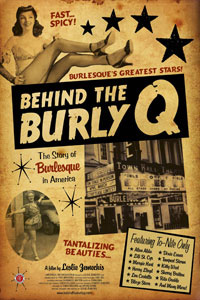Sun 25 Apr 2010
Q Rating
Posted by Ethan under Film Review, NYC Film Critic
Comments Off on Q Rating
Behind the Burly Q
Directed by Leslie Zemeckis
**1/2
If nothing else, Leslie Zemeckis’ new documentary Behind the Burly Q functions as a lovingly made scrapbook for the memories of the men and women that populated the burlesque scene in the ’30s, ’40s and ’50s.
A burlesque enthusiast and sometimes performer herself, Zemeckis (who is married to Robert Zemeckis, the of such box-office hits as Who Framed Roger Rabbit? and Back to the Future) spent the past few years tracking down some of the biggest names from that golden age–women like Tempest Storm, Blaze Starr and Betty Rowland–in order to preserve their faces and voices on film. In fact, the closing credits reveal that many of the performers interviewed in the documentary have since passed on, which adds an undeniable poignancy to the proceedings.
Zemeckis’ list of subjects also includes several social historians as well as the offspring of dancers and comedians that have already died, including the daughter of Lou Costello (who got his start on the burlesque circuit before becoming one-half of the legendary double-act Abbot & Costello) and actor Alan Alda, whose father Robert spent much of his career as a straight man in burlesque shows. These men and women offer compelling insights into a world that no longer exists without wholly romanticizing an industry that had a distinct dark side.
Several performers describe marital problems brought about by their choice of career, as well as various addictions and other hardships they faced over the years. Despite all of that, they speak of their profession with obvious pride. For many of them, burlesque was a way out of lives marked by poverty and pain as well as an outlet to celebrate their talents (and bodies) on stage in front of an appreciative audience. While we tend to think of previous generations as being more conservative than our own, burlesque shows had an easy, almost joyous sexuality that can be hard to find in today’s increasingly puritanical mainstream entertainment.
Like the people she interviews, Zemeckis’ love of burlesque comes across loud and clear and the variety of talking heads and archival material she’s assembled is impressive. But as a director, she’s ultimately guilty of being too close to her material. She admires these performers and the time and place they inhabited so much, she can’t find a way to tell their individual stories–as well as the larger tale chronicling the rise and fall of burlesque–effectively. From the beginning, the film displays a distinct lack of focus that only grows more pronounced as it moves along. It’s not even that Zemeckis doesn’t place events in chronological order–she has trouble maintaining a basic scene-to-scene continuity for the topics being discussed. An interview in which a performer describes say, a favorite theater, is abruptly followed by another person talking about an entirely different subject. Without a strong throughline to fall back on, Behind the Burly Q quickly becomes a muddled grab-bag of reminiscences and testimonials about burlesque’s place in the history of popular culture. This is a story that’s well worth telling; it just requires a more disciplined approach than Zemeckis demonstrates here.          Â
Behind the Burly Q opened in New York on Friday. Visit the film’s official website to learn additional release dates.


No Responses to “ Q Rating ”
Sorry, comments for this entry are closed at this time.